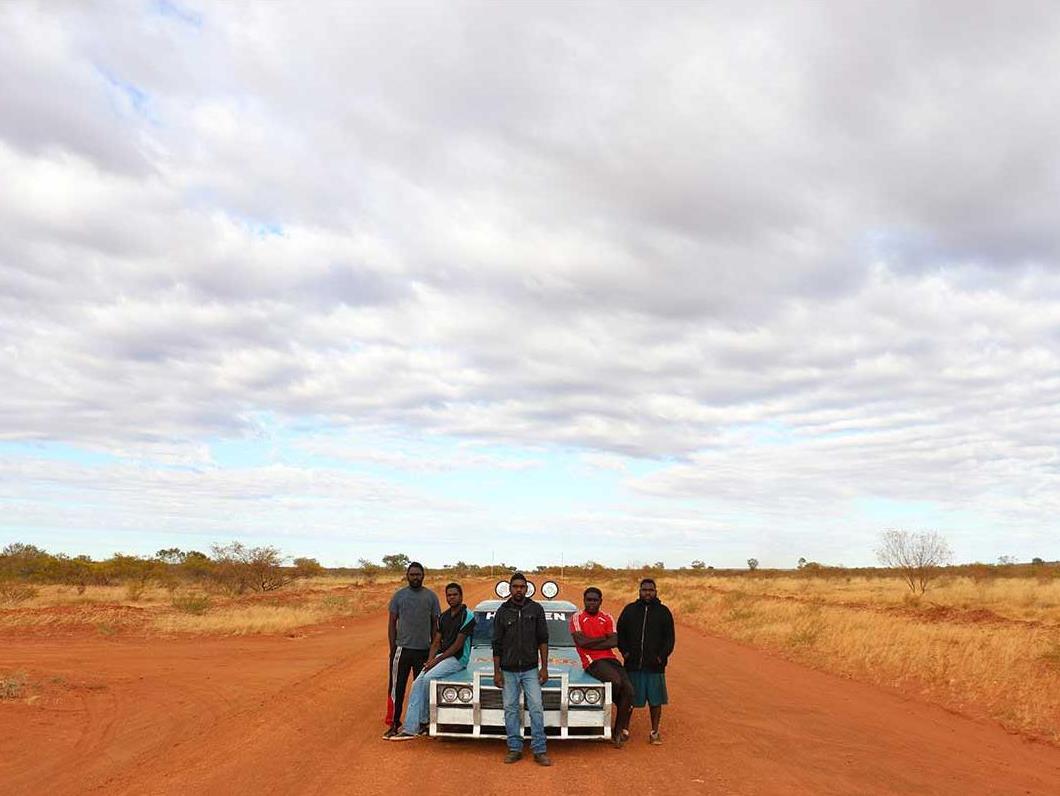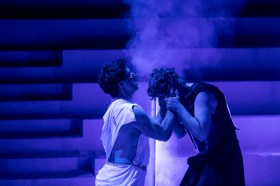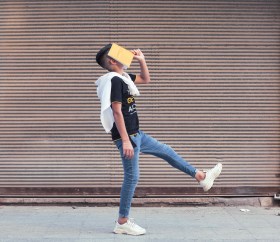Image: Wutunugurra Storm Press. Supplied by Barkly Regional Arts.
Thick dirt cakes the undersides of the trusty Barkly Regional Arts fleet of four-wheel drives. They need a helicopter to properly serve the vast swathe of the Northern Territory (20% of its total landmass) that they call their own, but they don’t have one. The chunk of land is larger than the entire state of Victoria, but they make do with a handful of ancient Landcruisers and deteriorating roads.
Barkly Regional Arts have a mission, and they take it very seriously: they bring the audience to the art, the gallery system to the artist. The business model won’t change, because it can’t. Like a wire transmitting power across a nation, Barkly Regional Arts connects the region’s people with the rest of the nation, a feat which for some remote communities is truly remarkable.

Mungkarta Living Culture, White Ochre. Supplied by Barkly Regional Arts.
‘I’m only half kidding about the helicopter,’ Alan Murn of Barkly Regional Arts laughs, his voice snapping and crackling over the phone line, ‘but that really is the kind of resource we need to do this job properly and it’s the thing people don’t really get when they think about a group like ours. Transportation is the hardest and one of the most important things we do, it’s just that remote.’
A quick browse of their website shows the breadth and calibre of the organisation’s collaborations, encompassing everything from music to visual art, radio and writing. They’ve had to be innovative to make their resources last, abandoning short-term projects for self-sustaining long-term programs. They spend days in each community in monthly rotation delivering arts skills and supplies and to make arrangements for exhibitions and performances elsewhere. The few staff on the payroll work long and hard to facilitate feats which surely count as magic.
Learn more about Barkly Regional Arts
‘Indigenous art forms are indivisible,’ says Artistic Director Kathy Burns, ‘they’re holistic and all-encompassing. It doesn’t make sense to think of the art coming from these communities as just painting, just dance, just song. It’s more than that; it’s an entire culture and history of which this one thing is just a piece.’
The organisation’s home is in Tennant Creek, including their gallery; an invaluable resource for winning the recognition these far-flung artists deserve. One hundred per cent of the funds raised from art sales go back to the community which produced the artwork: 60% directly to the artist, and 40% to the community collective, using the success of one to fund the participation of many.
Key to Barkly Regional Arts’ remit is non-interference. The organisation doesn’t dictate the projects and programs it facilitates, but instead visits remote parts of their territory, providing the tools and knowledge for the community to create their own work. By keeping the production of creative works in the land which inspired them, the local artists are able to transcend the homogenising power of city art scenes and stressors.
Through the exploration of each community’s rich linguistic, geographical and cultural landscape, Barkly Regional Arts hopes to provide purpose to townships in danger of disappearing, and already all but invisible.
‘We help produce excellent quality arts across a range of media with a small staff, long hours and low resources. And we do it to instil pride in these unique communities, and help them find ways to display their specialness,’ Burns says.
Explore the range of arts on offer in the Barkly Region
To the communities Barkly Regional Arts assists, the muddy cars loaded with paintings, pottery and performers represent a new industry, one many thought was impossible. The sheer distances between townships and the variation of terrain between provide the isolation required to build unique events, drawing other communities closer.

Lindy Brodie Living Portraits. Supplied by Barkly Regional Arts.
The Media Mob is a program training young people in digital media, including film, photography, sound recording, audio editing, social media, web design, vision mixing, live web streaming and lighting, and those young people are becoming documentary crews, showing the world through their lens. Textiles makers working in canvas, weaving and silk are making designs in these remote communities right now, waiting to take an unwitting city crowd by storm along with the painters and dancers.
‘We want to build pride, and respect;’ says Burns, ‘we want to create the kind of understanding where people are really open to Indigenous art, where they understand that there are the many dreamings and languages and cultures and that’s the point that leads to real appreciation.’
Visit barklyarts.com.au for more details.






